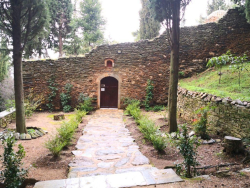Asteriou Monastery

Asteriou Monastery
The small monastery is founded on a quiet mountainside to a cross and wooden bench at a 545m elevation that provides an engaging view of Athens. A first historical reference says that the metropolitan of Athens "Asterios" had been highly instrumental in the creation of the monastery around the 5th Century. However, the sanctuary is not mentioned in the formal metropolitan records of that time. Conversely, this is refuted according to a second version "St. Lukas of Stiriou", who became a monk and lived in the monastery around 920 A.D. Later on he left for the city of "Lebadia" building the famous monastery of St. Lukas - whose memory is commemorated on February 7th. The insistence of the above historical approach is that the name of "Moni Asteriou" was given by paraphrasing the word "Lukas of Stiriou" finally leading to "Asteriou".
The earliest reference for the monastery is from the 10th Century. Approaching the cloister, we observe that the whole building is protected by a wall like a small castle - protecting at the same time the main church "Catholicon’’ and 2 other small buildings nearby. The catholicon existed at least since 1646, as it is shown by the carvings that exist on its walls. According to the inscription that survives in the church, the monastery was a patriarchal stauropegic one since 1716. It was an educational facility with an excellent library that was destroyed in 1687 during the invasion of the Venetians under Morosini. Later, in 1826-1827, the last remains were transferred to the grounds of the Acropolis in Athens for greater safety. In 1833, according to law by the regency of Otto, the monastery was dissolved and was abandoned. In 1960, Queen Frederica undertook its renovation and to add new buildings. Since that moment both structures are well endowed and conserved. Following the way down we also see the dilapidated Byzantine Tower of Anthousa.
Moni Asteriou belongs to the Monastery of Asomaton Petraki that is subjected to the Holy Archdiocese of Athens as regards to its religious aspect. Monks have occupied Moni Asteriou since 1960. Up until then, it functioned as an ecclesiastical monument inspected by the 1st Archaeological eforiate of Athens. In the present time, it is supported by the brotherhood of the superintendent monastery, Moni Asomaton Petraki, which endeavors to communicate with a dynamic spiritual attendance its Orthodox worship to God. For this reason, particularly if weather permitted, divine services are performed there.
The sanctuary of Asteriou, just as the Monastery of Asomaton Petraki, is dedicated to the Holy Archangels (Gabriel and Michael). Interestingly, the word "asomaton" directly translates to "bodiless" and invisible to our physical eyes, like the angels and archangels. According to Orthodox tradition, angels have no bodily needs or desires and passions, no cares about food, drink clothes or shelter. They have no worries they neither marry nor are given in marriage and no fear death. God created them before man nor do they age, but remain unchangingly youthful, beautiful and strong being already immortal.
The complex has the form of a fortress which develops inside a 4-squared precinct. At its center is the catholicon, which belongs to the type of complex four columned, cross-in-square church with a tripartite narthex on the western side. Its walls are built according to rock masonry and its dome, which belongs to the simplified "Athenian" style that are supported by 4 columns shaped by limestone plastered drums.
The interior of the church of the monastery is particularly interesting because it is entirely decorated with a wall painting dated back to the 16th Century. They are the works of simple and provincial art. Apart from the Catholicon, today survive the cells, the refectory and the external area, and the fountain. The buildings themselves were spared from a fire but unfortunately, a remarkable part of the internal paintings was destroyed - including the wooden column used as a connection with the roofed surface of the church.
Despite the gradual degradation suffered by the area’s ecosystems, a thoroughly devised and well-organized campaign for the conservation and restoration of the mountain’s natural beauty can prevent further deterioration. Hymettus mountain is endowed with unique biodiversity, which is amazingly rich despite the mountain’s proximity to the city of Athens. The natural environment is well protected by a non-profit organization named "Philodasiki Enosis Athinon" founded in 1899 in Athens.
Moni Asteriou is a historical monument presenting an exceptional archaeological, historical, traditional and artistic significance along with the theological one, pointing out the perfect dedication to prayer and worship of God. For this reason, the preservation of the monument and the whole natural environment must be encouraged to create an area of incomparable natural beauty and spiritual tradition.








